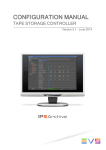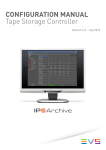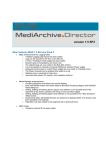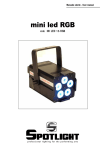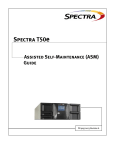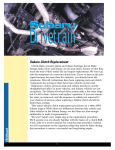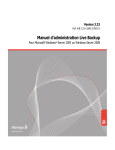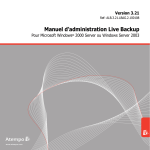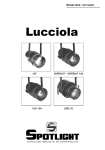Download APPLICATION NOTES IP2ARCHIVE
Transcript
APPLICATION NOTES IP2ARCHIVE Corporate North & Latin America Asia & Pacific Other regional offices Headquarters Headquarters Headquarters Available at +32 4 361 7000 +1 947 575 7811 +852 2914 2501 www.evs.com/conctact APPLICATION NOTES INTRODUCTION ............................................................................................................. 4 WHY DO WE NEED IP2ARCHIVE? ............................................................................................................ 4 PREREQUISITES ........................................................................................................... 4 HARDWARE REQUIREMENTS .................................................................................................................. 4 SOFTWARE REQUIREMENTS ................................................................................................................... 4 IP2ARCHIVE HARDWARE COMPONENTS ............................................................................................... 4 OTHER HARDWARE REQUIREMENTS (MAY BE PRE-EXISTING) ......................................................... 4 OPTIONAL TO THE SYSTEM ..................................................................................................................... 4 THIRD PARTY HARDWARE AND SOFTWARE ......................................................................................... 5 HSM SYSTEMS ........................................................................................................................................... 5 LTO TAPE LIBRARY .................................................................................................................................... 5 PRODUCT DESCRIPTION ............................................................................................. 6 IP2ARCHIVE ................................................................................................................................................ 6 ARCHIVE METADATA ................................................................................................................................. 6 IP2ARCHIVE COMPONENTS ..................................................................................................................... 7 RACK LAYOUT EXAMPLE .......................................................................................................................... 7 WORKFLOW DESCRIPTION.......................................................................................... 8 ARCHIVE AND RESTORE BIN HIERARCHY ............................................................................................. 8 ARCHIVING ................................................................................................................................................ 11 ARCHIVING MASTER CLIPS .................................................................................................................... 11 ARCHIVING SUB-CLIPS............................................................................................................................ 12 REMOVING THE HIGH-RESOLUTION FILE ............................................................................................ 12 INTRODUCTION ........................................................................................................................................ 12 RESTORING CLIPS ................................................................................................................................... 12 FULLY RESTORING CLIPS....................................................................................................................... 12 PARTIALLY RESTORING CLIPS .............................................................................................................. 15 PURGING CLIPS ....................................................................................................................................... 17 INTRODUCTION ........................................................................................................................................ 17 WORKFLOW .............................................................................................................................................. 17 TYPICAL WORKFLOW DIAGRAM ............................................................................................................ 17 28 janvier 2014 AN.IP2Archive.02 APPLICATION NOTES LEGAL INFO © 2013 EVS Broadcast Equipment, all rights reserved. No part of this documentation or publication may be reproduced, transcribed, stored in a retrieval system, translated into any language, computer language, or transmitted in any form or by any means, electronically, mechanically, magnetically, optically, chemically, photocopied, manually, or otherwise, without prior written permission from EVS Broadcast Equipment. DISCLAIMER The information in this document is believed to be correct as of the date of publication. However, our policy is one of continual development so the information in this guide is subject to change without notice, and does not represent a commitment on the part of EVS Broadcast Equipment. TECHNICAL SUPPORT For the latest news, upgrades, documentation, and products, please visit the EVS website at www.evs.com. LAST UPDATED 28 January 2014 28 janvier 2014 AN.IP2Archive.02 APPLICATION NOTES INTRODUCTION IP2Archive is aimed at clients looking to add digital archive management functionality to their existing IPDirector workflows. The goal is to let IPDirector control an HSM and its associated LTO data tape robot (max. 200 slots). It is not intended as an asset management or archive system, but a means of adding archive functionality to create a closely-coupled archive to the nearline store. WHY DO WE NEED IP2ARCHIVE? IPDirector can interface with a deep archive, but in an essentially manual workflow, using watch folders to deliver content to the hierarchical storage management network, and using the HSM’s functionality to retrieve content. IP2Archive allows this process to be largely automated, boosting productivity and ensuring that content is securely archived. PREREQUISITES HARDWARE REQUIREMENTS The following hardware requirements should be met: An XTAccess should be present for creating the low resolution versions SOFTWARE REQUIREMENTS At least IPDirector 5.99.30 and 6.07.90 (API version) In IPDirector, XTAccess must be configured for the creation of low-resolution files Remote access to the IP2Archive setup for EVS support and maintenance should be provided IP2ARCHIVE HARDWARE COMPONENTS ORACLE database server Management server Application server OTHER HARDWARE REQUIREMENTS (MAY BE PRE-EXISTING) HSM server and its necessary components LTO robot Nearline storage IPDirector workstation OPTIONAL TO THE SYSTEM Redundant ORACLE database server Asset management workstations (can be installed on the IPDirector hardware) 28 janvier 2014 AN.IP2Archive.02 APPLICATION NOTES THIRD PARTY HARDWARE AND SOFTWARE HSM SYSTEMS IP2Archive can be installed with the following third party hierarchical storage management systems: Front Porch Digital DIVArchive XenData Digital Archive Atempo Digital Archive (ADA) SGL FlashNet LTO TAPE LIBRARY The preferred LTO robot system is Spectralogic, although the IP2Archive system interfaces with the HSM software and not directly with the LTO robot itself. Thus any robot that can be controlled by the supported HSM systems is supported by the IP2Archive software. 28 janvier 2014 AN.IP2Archive.02 APPLICATION NOTES PRODUCT DESCRIPTION IP2ARCHIVE The heart of IP2Archive is its kernel which interacts with IPDirector and pilots an HSM and LTO robot. It is a plug-in that facilitates the connectivity between IPDirector and a HSM/LTO robot combination. IP2Archive consists of several applications (see below), each with a specific function, running on an application server connected to an Oracle Database. When installing IP2Archive, an “archive bin” hierarchy is created in the IPDirector database. These specific bins are added: > > ARCHIVING > Bin 0: 0_REQUEST ARCHIVE > Bin 1: 1_ARCHIVE IN PROCESS > Bin 2: 2_ARCHIVED > Bin 3: 3_ARCH REJECTED > Bin 4: 4_ARCHIVE FAILED RESTORING > Bin 0: 0_REQUEST RESTORE > Bin 1: 1_RESTORE IN PROCESS > Bin 2: 2_RESTORED > Bin 3: 3_RESTORE FAILED ARCHIVE METADATA Internally, a clip is always identified by its VarID, which must remain the same (for both full resolution and low resolution versions) when an asset is archived. The clip metadata can be enhanced via user fields. The following user fields have been defined in IPDirector when installing IP2Archive: > > > > > Archive status > Unknown > Request archive > Archive storage assigned > Archive requested > Archiving > Archived > Archive error > Request restore > Restore storage assigned > Restore requested > Restoring > Restore error Archive progress (eg 75%) Archive progress message Archive LTO tape Archive group The last three bins have limited user rights so that not everyone can access them. The first bin does not require any specific user rights. Throughout the archive process, the clip is always identified by its VarID. This metadata has to be applied to all metadata profiles used in the IPDirector setup. If no metadata profile has been assigned to a clip to be archived, the IP2Archive assigns a default metadata profile. 28 janvier 2014 AN.IP2Archive.02 APPLICATION NOTES IP2ARCHIVE COMPONENTS > > > > > > > Deep Archive Manager: GUI-based application that allows librarians to manage the nearline storage by archiving and restoring clips to and from the deep archive. It provides the librarian a list of candidate clips to archive, the librarian can archive the selected clips or can refuse clips for archiving. Once the clip is archived, the Deep Archive Manager can also restore it to the nearline storage, and monitor the restore process. Deep Archive Controller: An automated application or robot that picks up archive and restore archive requests from IPDirector and Deep Archive Manager, archives and restores the clips and provides feedback on the progress of the restore to IPDirector. For the restore process the controller needs to monitor the online content and the archived content and check for status changes. Once a clip is archived by the librarian using the Deep Archive Manager, the controller removes the corresponding entry from the IPDirector database and deletes the high resolution version from the nearline storage. Deep Archive Sync: An application which allows the administrator to compare the archive metadata of clips in the archive database with that in the IPDirector or DivArchive database, to ensure they are maintained in synchronisation. This is particularly important when sub-clips are created from existing clips and metadata copied, which may result in a new clip being shown as having been archived when it has not. IP2Archive Configurator: the application which allows the system administrator to configure the applications and the connections between IP2Archive and the HSM system. It also allows the administrator to create users and assign them operational rights. IPDirector Communicator: an automated application that communicates with the IPDirector application, and updates the archive metadata. Tape Storage Controller : An automated application that interacts with the Front Porch Digital, Atempo or SGL archiving software to drive all the archive and restore requests. File Transfer Daemon: an automated application that interacts with the XenData cache software to manage transfers between the archive and the IPDirector environment. RACK LAYOUT EXAMPLE Rack Cisco Switch (24 ports) Oracle IP2Archive App Server HSM (Xen Data or Diva) Tape Robot (ex. Spectra Logic T50) Power 212 W 320 W 320 W BTU 1023 BTU/h 1093 BTU/h 1093 BTU/h # power sockets 2 2 2 28 janvier 2014 AN.IP2Archive.02 APPLICATION NOTES WORKFLOW DESCRIPTION ARCHIVE AND RESTORE BIN HIERARCHY When IP2Archive is installed, an archive and restore bin hierarchy is created in the IPDirector database. This bin hierarchy allows users to easily archive and (partially) restore clips by a simple drag-and-drop operation. It also allows them to keep track of the clip archive or restore status. Each bin represents a stage in the archive or restore process. The location of a clip in a particular bin betrays its status. When the status of a clip changes, it is moved to the bin that corresponds to its status. In the example below, six bins have been created for the archive process and five for the restore process. An additional bin has been created for generating subclips. The IPDirector operator searches for clips to archive. He/she verifies that the clip is not archived yet. He/she then verifies in the IPDirector Database Explorer that the clip contains a hi-res and lo-res file on the nearline. If not, He/she asks IPDirector to send the clip to the nearline storage. XTAccess will then create a hi-res and a lo-res file. The IPDirector operator drags and drops the clips in the “Request Archive” bin. The operator can verify the progress of the archive operation via the “Archive LTO Tape”, “Archive Group”, “Archive Status”, “Archive Progress” and “Archive Progress Message” user fields. The IP2Archive Communicator will monitor these bins, pick up the archive and restore requests and insert them in the IP2Archive database. Depending on their archive status, it will move the clips to the corresponding bin. 28 janvier 2014 AN.IP2Archive.02 APPLICATION NOTES If the “Request Archive” bin is defined as the user default bin, the operator can also right-click on the clip he/she want to archive and choose “Send to” -> “Default Bin”. The IP2Archive IPDirector Communicator polls the content of the Request Archive bin in IPDirector through the IPDirector API. The archive requests are picked up and inserted in the IP2Archive database. The clips to be archived appear in the Archive Candidates tab of the Deep Archive Manager. The librarian selects the clips to be archived and clicks the Archive button. These requests are picked up by the Deep Archive Controller and the archive process is performed in the same way as for clips based on genealogy. The IP2Archive Deep Archive Controller will set a “change” flag and request the IP2Archive IPDirector Communicator to update archive data in IPDirector by filling in the following custom user fields: > Archive Status > Unknown > Request archive > Archive storage assigned > Archive candidate > Refused > Archive requested > Archiving > Archived > Archive error > Request restore > Restore storage assigned > Restore candidate > Restore requested 28 janvier 2014 AN.IP2Archive.02 APPLICATION NOTES > > > > > > Restoring > Restore error > Purge candidate > Purge requested > Purging > Purged > Purge error > Partially restored > Remove hi-res candidate > Request remove hi-res > Removing hi-res > Cleanup requested > Cleaning up Archive progress Archive progress message Archive LTO tape Archive group Archive date > Archive status > Archive status message The IP2Archive IPDirector Communicator also provides feedback to IPDirector by placing the clip in the Archive In Process bin. When the archive job is finished, the clip will be moved to the final bin ( Archived). If anything goes wrong, the clip is placed in the error bin(Archive Failed). If the clip gets rejected, the clip is placed in the Archive Rejected bin. These last three bins have limited user rights so that not everyone can access them. The first bin does not require any specific user rights. Throughout the archive process, the clip is always identified by its VarID. 28 janvier 2014 AN.IP2Archive.02 APPLICATION NOTES ARCHIVING ARCHIVING MASTER CLIPS The archiving of master clips proceeds as follows: 1. In the Database Explorer of IPDirector the user searches for the clips to archive. 2. They drag and drop the clips in the Request Archive bin. If the Request Archive bin has been defined as the user default bin, the user can also right-click on the clip and choose Send to > Default Bin. 3. IP2Archive Communicator, which continuously polls the Request Archive bin, detects the clips and enters the archive requests in the IP2Archive database. It moves the clips to the Archive in Progress bin. 4. Depending on how the Deep Archive Manager is configured, the clips to be archived will either appear in the Archive Candidates tab or in the Archive Queue tab. In the first case, a librarian has to manually decide if the clips can be archived or not. If the librarian accepts the clips, the corresponding high-resolution video file and its metadata XML will be archived to LTO. In the second case, the clip has been automatically accepted by the Deep Archive Manager, and will immediately appear in the Archive Queue tab. 5. The Deep Archive Controller picks up the archive requests in the IP2Archive database. It checks if an HSM is available, and if this is the case it assigns the archive requests to it. It then commands Tape Storage Controller (DIVArchive, FlashNet, ADA) or File Transfer Daemon (XenData) to initiate the archive process. 6. File Transfer Daemon will copy the high-resolution files and their metadata XML from the nearline storage to the XenData Cache. Tape Storage Controller and File Transfer Daemon will request the HSM to start the archive process. 7. The high-resolution video files and their metadata XML are copied to LTO. During the archive process, IP2Archive Communicator provides feedback to IPDirector by updating the clip archive metadata. If anything goes wrong, the clip will be placed in the Archive Failed bin. 28 janvier 2014 AN.IP2Archive.02 APPLICATION NOTES 8. Once the files are successfully archived, the clips are moved to the Archived bin in IPDirector. In Deep Archive Manager the clips appear in the Archived tab. ARCHIVING SUB-CLIPS If the user creates a sub-clip of an existing clip in IPDirector and drag and drop this sub-clip in the Request Archive bin, this sub-clip will still refer to the high- and low-resolution video file of the source clip, which may be a problem if the source clip gets archived. To avoid this, IP2Archive Communicator will copy the sub-clip first to the Sub-clip Generation bin. An XML job is sent to XTAccess to create high- and low-resolution files of this sub-clip on the nearline storage. Once the high- and low-resolution files are created, this will be picked up by the IP2Archive Communicator and the clip will be requested for archiving. REMOVING THE HIGH-RESOLUTION FILE INTRODUCTION From within the Deep Archive Manager interface it is possible to remove the high-resolution video file of archived clips from the IPDirector nearline storage in order to free up space. This can also be done through the IPDirector interface, but it is strongly advised to perform the removal through the Deep Archive Manager interface in order to minimise possible mistakes, such as accidentally removing the low-resolution video file as well. It is also possible to automate this process. The removal of the high-resolution video file of archived clips from the IPDirector nearline storage proceeds as follows: 1. In the Deep Archive Manager, the user opens the Archived tab. 2. They select the clips whose high-resolution video file is to be deleted from the IPDirector nearline storage and adds them to the selection list. 3. They click the Remove Hi-res button. The Deep Archive Controller picks up the removal request in the IP2Archive database. It commands IPDirector to remove the high-resolution video file from the IPDirector nearline storage. 4. In the Deep Archive Manager the clips are moved to the Remove Hi-res Queue tab. 5. Once the high-resolution video file has been removed, the clips are moved to the Hi-res Removed tab in Deep Archive Manager. IP2Archive Communicator will provide feedback to IPDirector by updating the clip archive metadata. RESTORING CLIPS FULLY RESTORING CLIPS INTRODUCTION Clips can be fully restored by dragging them into the Request Restore bin in IPDirector, or by selecting the clips in the Hi-res Removed tab of the Deep Archive Manager and by clicking the Restore button. 28 janvier 2014 AN.IP2Archive.02 APPLICATION NOTES RESTORING CLIPS IN IPDIRECTOR The restore workflow in IPDirector proceeds as follows: 1. In the Database Explorer of IPDirector the user searches for the clips whose high-resolution video file has to be restored to the nearline storage. 2. The user drags and drops the clips in the Request Restore bin. If the Request Restore bin has been defined as the user default bin, the user can also right-click the clips and choose Send to > Default Bin. See the IPDirector user manual for more information about setting a particular bin as default bin. 3. IP2Archive Communicator, which continuously polls the Request Restore bin, detects the clips and enters the restore requests in the IP2Archive database. It moves the clips to the Restore in Progress bin. 4. In the Deep Archive Manager the clip appears in the Restore Queue tab. 5. Deep Archive Controller picks up the restore requests in the IP2Archive database. It checks if an HSM is available, and if this is the case, assigns the restore requests to it. It then commands Tape Storage Controller (DIVArchive, FlashNet, ADA) or File Transfer Daemon (XenData) to initiate the restore process. 6. Tape Storage Controller or File Transfer Daemon request the HSM to start the restore process. 7. The high-resolution video files are restored from LTO tape. DIVArchive, FlashNet and ADA will restore the files directly to the nearline. XenData will restore the files to its cache. File Transfer Daemon will then transfer the files to the nearline storage. During the restore process, IP2Archive Communicator provides feedback to IPDirector by updating the clip archive metadata. If anything goes wrong, the clips will be placed in the Restore Failed bin. 8. Once the high-resolution files of the clips are successfully restored, the clips are moved to the Restored bin in IPDirector. In Deep Archive Manager the clips appear in the Archived tab and also in the Restored tab. 28 janvier 2014 AN.IP2Archive.02 APPLICATION NOTES RESTORING CLIPS IN THE DEEP ARCHIVE MANAGER The restore workflow in Deep Archive Manager proceeds as follows: 1. In the Hi-res Removed tab of the Deep Archive Manager the librarian selects the clips to be restored and clicks the Restore button. 2. Deep Archive Controller picks up the restore requests in the IP2Archive database and initiates the restore process as described above. 3. The clips are moved to the Restore Queue. 4. Once the high-resolution files of the clips are successfully restored, the clips appear in the Archived and Restored tab. 28 janvier 2014 AN.IP2Archive.02 APPLICATION NOTES PARTIALLY RESTORING CLIPS INTRODUCTION Partially restoring clips is only possible: In IPDirector, not in the Deep Archive Manager. If IP2Archive interfaces with Front Porch Digital DIVArchive, SGL FlashNet or Atempo Digital Archive. If the license for partial restore has been activated on the hierarchical storage management system. If the hierarchical storage management system supports partial restore for the file format of the clip’s high-resolution video file. If the clip's high-resolution video file is archived. if the clip's low-resolution video file is available on the IPDirector nearline storage. WORKFLOW 1. In the IPDirector Database Explorer the user searches for the low-resolution video file of a clip that has been archived. 2. The user sets new In and Out points within the boundaries of the archived clip. 3. The user then creates a sub-clip by clicking New Clip. 4. The user enters a name for the clip. He/she can also enter a VarID, but this is optional. If no VarID is entered, it will be automatically generated. 5. The user clicks the Save button. 28 janvier 2014 AN.IP2Archive.02 APPLICATION NOTES 6. The user drags and drops the clip in the Request Restore bin. 7. IP2Archive Communicator, which continuously polls the Request Restore bin, detects the clip and enters the restore requests in the IP2Archive database. It moves the clip to the Restore in Progress bin. In the Deep Archive Manager the clip appears in the Restore Queue tab with the status 'Restoring'. The VarID of the archived high-resolution file is retrieved from IPDirector using the full file path of the lowresolution video file the sub-clip was created from. It is compared with the VarID of the sub-clip. If the VarID of this sub-clip already exists in the HSM, this request is handled as a “Full Restore”. If the VarID does not exist, the request is handled as a “Partial Restore”. The in and out timecodes of the sub-clip are compared with the timecodes of the archived high-resolution file. If the timecodes match, this request is handled as a “Full Restore”. If the timecodes fall within the timecode boundaries of the archived file, the request is handled as a “Partial Restore”. A new clip will be restored using the VarID of the sub-clip as the name for the restored high-resolution file: VARID.xxx, together with the metadata file : VarID.evs.xml. 8. Once the sub-clip has been successfully restored to the nearline storage, it will be moved to the Restored bin. In Deep Archive Manager the clip appears in the Restored tab. The field in the column ‘Partial’ is checked. IPDirector will pick up the restored file in its database and link it to the lowresolution sub-clip previously made. 28 janvier 2014 AN.IP2Archive.02 APPLICATION NOTES PURGING CLIPS INTRODUCTION If an archived clip becomes obsolete and needs to be purged from the archive and LTO tape, it is possible to do this from the Deep Archive Manager. You can purge clips in the Archived or in the Hi-res Removed tab. WORKFLOW The purging of clips from LTO tape from within the Deep Archive Manager proceeds as follows: 1. In the Deep Archive Manager the user opens the Archived or Hi-res Removed tab. 2. They select the clips to purge and adds them to the selection list. 3. The user clicks the Purge button. Deep Archive Controller picks up the purge request in the IP2Archive database and commands Tape Storage Controller (ADA, FlashNet or DIVArchive) or File Transfer Daemon (XenData) to request the HSM to start the purge process. In the Deep Archive Manager the clips are moved to the Purge Queue tab. During the purge process, IP2Archive Communicator provides feedback to IPDirector by updating the clip archive metadata. 4. Once the clips have been purged from LTO tape, the clips are moved to the Purged tab. Note: The clips will only be physically removed from the LTO tape once a repacking of the tapes by the HSM is performed. TYPICAL WORKFLOW DIAGRAM 28 janvier 2014 AN.IP2Archive.02 APPLICATION NOTES 28 janvier 2014 AN.IP2Archive.02




















